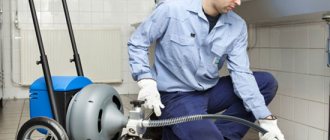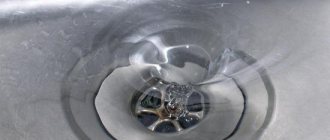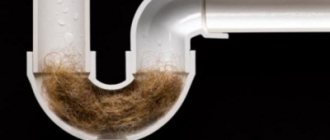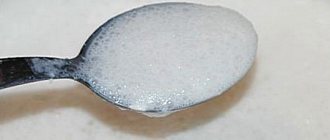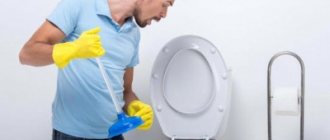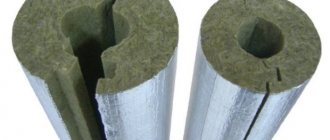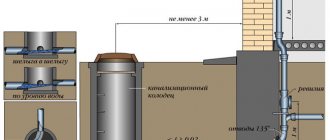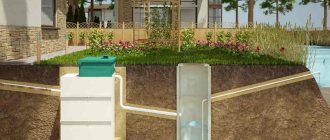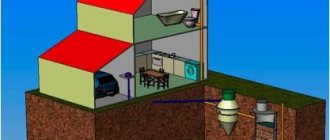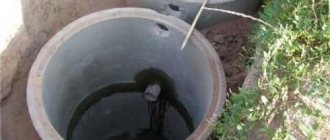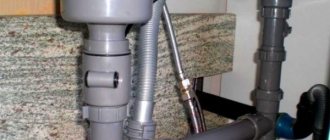Blockages in pipes are an extremely unpleasant phenomenon that every housewife periodically encounters. The variety of cleaning products on store shelves can sometimes be confusing: which one is the most effective?
In this case, their cost also plays an important role. Using baking soda and vinegar to clean your drains will help solve these problems.
Causes of blockages
Blockages in sewer pipes are a fairly common occurrence. There may be several reasons for this:
- Lack of slope of the sewer circuit towards the riser or, conversely, its redundancy, excessive tortuosity.
- Accumulation of fat and dirt insoluble deposits on the inner walls of pipes. Small debris is subsequently layered on it. This leads to a gradual narrowing of the passage opening, completely blocking the sewer flow and requires careful cleaning.
- The same effect occurs due to poor water quality. The minerals included in its composition form a limescale deposit, which only thickens over time.
- Particles of earth and sand washed from shoes into the sink, or foreign objects and household waste entering sewer pipes from a toilet or bathtub, accumulate in the recesses and cling to the joint elements, preventing the free passage of drains.
- Poor condition of the pipeline. Roughness of the walls, corrosion of cast iron pipes or careless installation of joints (fracture, protrusion of O-rings, tow) leads to the formation of irregularities in the internal circuit.
Prevention measures
Of course, trouble can happen in every home. Preventive cleaning of plumbing helps to significantly reduce the risk of dirt deposits forming.
- The pipes should be flushed monthly. To do this, just open the hot water tap for 10-15 minutes.
- To protect the kitchen sink from food waste, purchase special meshes. They accumulate dirt on themselves, preventing them from entering the system. The grill is easy to remove and clean.
- Of course, the most important thing is to prevent household waste, scraps, garbage, and hygiene products from entering the sewer system.
If you follow simple rules, your plumbing fixtures will serve you for a long time, and unpleasant cleaning procedures will not be necessary.
Advantages and Disadvantages of Baking Soda and Vinegar for Cleaning
The undoubted advantages of using soda and vinegar to clean sewer pipes:
- There are no restrictions regarding pipe material. Vinegar and soda will not cause any harm to either plastic or metal pipes during cleaning.
- The relative harmlessness of soda and vinegar to human health and the safety of cleaning in comparison with a number of industrial household chemical products designed to remove sewer blockages.
- Performance. Depending on the complexity of the situation, cleaning pipes with vinegar and soda can take from 5 minutes to 8 hours.
- Effectively combats fat deposits and in parallel with the fetid odor emitted by the sewer.
- Used for cleaning kitchen sink drains, bathroom sinks, bathtubs and showers themselves, as well as toilets.
The key advantage of the product is its availability and tangible financial savings, because almost everyone has vinegar and soda in their household, and finding them on the shelves of the nearest grocery store is not a problem.
There is perhaps only one drawback to a cleaning composition made from soda and vinegar - the difficulty in clearing complex blockages consisting of hair, fish scales and inorganic debris.
Useful tips
A fairly simple method of cleaning pipes and plumbing from dirt and grease can become even easier if you use the following tips:
- It is better to treat drain systems before going to bed or leaving for work, pouring a solution of vinegar and soda into the pipes for a longer period.
- It is strictly forbidden to treat plumbing fixtures and pipes with chemicals together with soda and vinegar. As a result, toxic compounds hazardous to human health may arise.
- Table vinegar can be replaced with wine vinegar. It has a lower concentration and is slightly less effective in combating blockages, but copes well with greasy and oily deposits.
When it comes to preventing blockages, the main thing is regularity. Timely prevention and quick response to the slightest signs of pipe obstruction will certainly reduce the risk of a large-scale domestic disaster. And using soda and vinegar for cleaning will make the process safe and affordable.
Other drain cleaning methods
Above we looked at cleaning methods that involve a mixture of vinegar and soda. However, there are other techniques that involve adding other ingredients:
- Vinegar can be replaced with 100-150 g of regular salt mixed with 200-500 g of baking soda and boiling water. The resulting mixture is poured down the drain and another 1.5 liters of boiling water is poured. The composition is kept in the pipe for about 8-10 hours, and then thoroughly poured.
- Crystallized tartar can be added to the previous composition. Ratio: baking soda and table salt 1 cup each, cream of tartar - ¼ cup. All ingredients are pre-mixed and then poured into the drain. For 1 hour, add boiling water every 10-15 minutes, and at the end, pour cool water over the system.
- Vinegar can be replaced with a packet of classic citric acid, which is diluted in 1 tbsp. warm water. This amount is enough for 250 g of baking soda.
How to remove a clog in a toilet?
Probably the most unpleasant clog is a clogged toilet. The cause is foreign objects washed into the pipeline, which often happens in families with small children. Rough handling, too large pieces of toilet paper, and discarded personal care products can also lead to clogs.
To begin with, you should try to suddenly pour a bucket of water into the toilet - the flow from the flush cistern does not provide the necessary pressure. If the water gradually disappears, repeat after 10 minutes. Use boiling water effectively.
In the case when washing is not enough, soda will again come to our aid.
- Pour a pack of soda into the toilet, flush and wait 1-2 hours.
- Pour half a pack of soda into the toilet, add 2 tbsp. vinegar, lower the lid. The more time passes, the better the result will be.
- To clear a more serious blockage, you should mix equal amounts of soda ash and regular soda and proceed according to the previous scheme.
If you suspect that a foreign object has gotten into the toilet, it is better to use a plunger or a plumbing cable. He will help you fish out the cork.
Preventing blockages
The best treatment is prevention. Therefore, it is better to prevent the formation of blockages in sewer pipes, and to do this, the so-called passive safety measures should be observed:
- Carefully remove food residues from dishes before washing.
- Install a protective grill on the drain hole to prevent debris and hair from entering the pipe.
- Periodically flush the system with boiling water.
- Once every 2 weeks to a month, use a light mixture of vinegar and soda to clean the drain.
How to unclog a sink?
If the water does not drain from the kitchen sink, food and grease residues are most likely to blame. The already familiar method of combining baking soda and vinegar will help.
You can also experiment and mix soda not with vinegar, but with regular salt - the latter draws out fat well. Mix the substances in equal parts and pour into the drain hole, wait, rinse with water. However, the “powder” method is not suitable for all blockages.
Sometimes, in order to properly clean the pipes, it is necessary to first use chemical action to soften the dirt, and then mechanical action to remove the remaining blockage. A plunger will help you cope with this.
Features of cleaning pipes with this device:
- The main processes when clearing blockages with a plunger are suction and pressure. To ensure effective use of the tool, you need to fill the sink with water about 10 cm. If there is too much water, reduce the amount using a ladle.
- If there is an overflow hole, it must be plugged with a rag or plug to limit the flow of air into the pipe.
- Immerse the bowl of the plunger under water and press firmly to the drainage area.
- Press down firmly on the handle at least 20 times.
The method is quite energy-intensive and requires some physical effort. But if you manage to create the necessary pressure, the water will easily go away.
Advice! If you don't already have a plunger in your home, cut off the neck of a regular plastic bottle and use it as described above.
Reviews
Most users respond positively to cleaning with soda and vinegar. There are also skeptics who, without even trying this method, express doubts about its effectiveness: they say, there is nothing there to deal with blockages. But, as they say, if you don’t try it, you won’t know. So, good luck, especially since the price of such an experiment will not exceed 50 rubles.
Advantages and disadvantages
This cleaning method is based on a violent reaction that occurs between acid and alkali. During it, fats, mucus, food particles and other deposits in the pipes dissolve.
The advantages of the method include:
- availability and cheapness
- safety for pipes
- odor removal
But there are nuances that are important to consider:
- The reaction of soda and vinegar is fleeting - it lasts only a few seconds. Therefore, you will have to act quickly, otherwise all your efforts will be in vain.
- Acetic essence is hazardous to health - if it comes into contact with the skin and mucous membranes, burns occur. You will have to work strictly with gloves; it is advisable to cover your face with a mask so as not to smell the pungent odor.
Attention! Keep children and animals away from the procedure area.
Cleaning rules
Cleaning pipes from debris requires the correct implementation of step-by-step measures:
- in the place of blockage, you need to remove the siphon between the plumbing fixture and the sewer pipe;
- clean it and put it in place, run water and check the drain for clogging;
- if the problem persists, mechanical action is required: the help of a cable or a plunger;
- after achieving a positive result, you should start cleaning the system with soda and vinegar to expand the permeability of the pipes.
Precautionary measures
During the event, you need to take care of safety measures:
- perform the procedure wearing protective gloves and goggles to protect the skin and mucous membranes from contact with reagents;
- The room where cleaning is carried out must be ventilated.
Cleaning Solution Recipes
To clean pipes from plaque, you can use different ratios of components:
| Purpose | Cleaning for prevention and for minor blockages | Removing difficult clogs | Removing deep traffic jams | Cleaning the toilet |
| Baking soda | 250 g | 125 g | 0.4-0.5 kg | 500 g |
| Soda Ash | 125 g | 75 g | 0.2–0.25 kg | 250 g |
| Table or apple cider vinegar | 100 ml | 125 ml | 0.75-1 l | 400 ml |
| Hot water | 1–1.5 l | 1 l | 2–3 l | — |
We recommend: The benefits and harms of vinegar in everyday life and for human health
Preparation of the solution
All recipes, except the second, do not require preliminary preparation of the composition . The components only need to be poured sequentially or poured into the drain. If the plug is too deep or the dry powder is inconvenient to pour, you need to prepare a liquid from it. To do this, add vinegar and soda to a common container. A natural chemical reaction will occur causing foam to appear. This is evidence that the mixture is ready.
Cleaning process
To carry out activities related to the need to eliminate deposits in different systems, you must proceed as follows :
- For sewer pipes, prepare 2 kg of caustic soda, a 10-liter plastic bucket and a scoop. Pour soda into half the bucket with water and stir. Pour the resulting contents down the drain and keep in the sewer for 3 hours (the system cannot be used during this time). At the end of the event, it is necessary to rinse the drain with water for a quarter of an hour.
- If there is a problem with the toilet, you will need 400 ml of vinegar and half a pack of baking soda to clean it. Pour the last ingredient into the drain and immediately add acetic acid. Use a brush to clean the surface of the toilet, then close the lid. You need to wait 30 minutes and thoroughly clean the toilet again with a brush, then rinse with water. Dense congestion can be destroyed with a composition of 5 tbsp. l. baking soda, as well as a similar amount of soda ash. Combine these reagents and pour them into the drain hole. After 30 minutes, pour 100 ml of vinegar into the drain and close the lid. After another half hour, clean the entire surface of the toilet with a brush and running water.
- To remove a blockage in the kitchen sink, you must first carry out mechanical cleaning. Food residues clog first the drain and then the siphon. If the water begins to drain slowly and a musty smell appears, you need to perform the procedure. When a plunger does not solve the problem, baking soda and vinegar will help. First you need to remove any remaining food from the sink and pump the pipe with a plunger. Then rub laundry soap in the amount of half a glass. Close the sink with the drain plug, fill it with hot water, into which pour soap shavings. After half an hour, remove the plug and pour 100 ml of table vinegar into the drain. Sprinkle baking soda on the surface of the sink and clean it thoroughly. Complete the procedure by pouring boiling water down the drain. Housewives are always interested in how long they need to wait before using the sink for household purposes after an event. The answer is simple - after half an hour, feel free to start your daily kitchen work.
We recommend: What is alcohol vinegar and how is it used?
Caustic soda against blockages
This product is not available in every home. They rarely buy it unless absolutely necessary. But if it is available, it will be useful for clearing the blockage.
Recommended for you:
How to get rid of unpleasant odor from shoes using baking soda at home
You will need:
- caustic soda (2-4 kg);
- water (5-7 l);
- durable plastic bucket;
- plastic spatula or scoop;
- latex or rubber gloves.
Cleaning process:
- Wear gloves.
- Using a spatula, pour caustic soda into the bucket.
- Fill with water, stir. The crystals should completely dissolve.
- Pour the mixture into the pipe.
During mixing, a chemical reaction occurs, the liquid heats up to approximately 60-70 degrees. This can be intimidating for some people the first time. But believe me, such a reaction is absolutely normal.
How to avoid blockages
Careful handling of pipes and a preventative approach will prevent blockages from forming:
- It is useful to periodically disassemble the system at the connection points under the sink (about once a month). Place a bucket, unscrew the connected elements, thoroughly clean and rinse them, and put them in place.
- The plunger creates positive and negative pressure in the pipes alternately, which helps displace the blockage and loosens it. Sometimes in this way it is possible to remove large objects that interfere with the normal outflow of water.
- A pipe cleaning cable (also called a flexible shaft) easily removes inorganic products. It removes deposits from pipes well and is able to push forward the formed plug - and all this without dismantling the main line.
- If you thoroughly clean your dishes of food debris before putting them in the sink, you will not have to deal with drainage problems or clogged pipes for longer. It is also good to clean greasy plates and pans with paper before washing. To do this, you can use toilet paper or old unnecessary rags. This will significantly reduce the penetration of grease into the pipes and its deposition on the walls of the system.
- You can eliminate grease if you periodically (every 7-10 days) pour about 2 liters of hot water into the pipes.
If independent actions do not lead to success, you will have to contact a specialist. However, if you have such an effective method as baking soda + vinegar, in most cases you can quickly remove the blockage.
Some nuances
However, there are factors that must be taken into account when cleaning pipes:
- This may be hazardous to your health. This means caustic soda. Therefore, be sure to follow safety precautions, including gloves and a mask.
- Heavy contamination can take a long time to remove. Very often about 10 hours, sometimes the procedure needs to be repeated several times.
- Before adding soda, make sure that the pipes are strong enough for the procedure, and that the material from which they are made will not deteriorate under the influence of a chemical reaction.
- If you cleaned the pipes with purchased products, then it is prohibited to use sodium bicarbonate and vinegar. This may lead to unexpected reactions. It is better to wait a day so that the store-bought substance has time to wash off.
Recommended for you:
How to wash dishes with baking soda at home
Precautionary measures
When using caustic soda and acetic acid to combat blockages, you must take the following precautions:
- Carry out the cleaning procedure wearing a mask and goggles.
- Ventilate the room after treatment.
- Avoid contact of substances with skin and mucous membranes.
- Protect your hands with gloves.
- If soda or vinegar accidentally gets on exposed areas of the body, rinse them with plenty of warm water.
- Do not leave products in places accessible to children.
- After treatment, thoroughly rinse the pipes with hot water.
